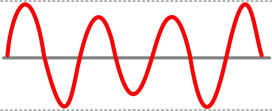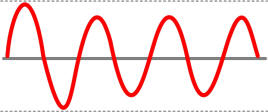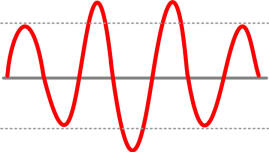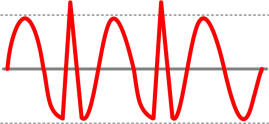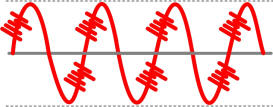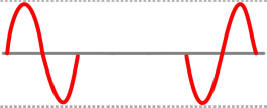In today’s modern technologically advanced society, technology is no longer simply a tool for survival, but rather has been turned into a means of mass communication and entertainment – making it easier than ever to connect with people.
While there is no doubting the benefit that the electronic and digital ages have brought to society, the reality of all these advancements is that the availability and quality of power needed to run these electric-powered machines and devices has not kept pace.
We list below some of the more common voltage problems that you are likely to encounter and their likely effect on your sensitive electrical and electronic equipment:
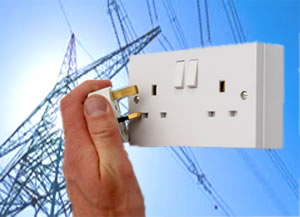
Voltage Sags
| Sags: are short duration decreases in the mains supply voltage which generally last for several cycles. |
| Formal Definition – Voltage below 80 to 85% of rated RMS voltage for 2 or more cycles. | |
| Typical symptoms – Sensitive equipment can lock or hang causing data loss and system resets. | |
| Common Causes – Heavy equipment turned on, starting large electrical motors, switching of the mains supply. | |
| Solutions – AC Voltage Stabiliser, Power Line Conditioner & Uninterruptible Power Supply. |
Brownouts
| Brownouts: are long term sags in the mains supply voltage which can last up to several days. |
| Formal Definition – A steady state of RMS voltage under nominal by a relatively constant percentage. | |
| Typical Symptoms – Equipment can reset or even shutdown. | |
| Common Causes – Heavy equipment turned on, starting large electrical motors, switching of the mains supply or just low voltage output from the generating source. | |
| Solutions – AC Voltage Stabiliser, Power Line Conditioner & Uninterruptible Power Supply. |
Over Voltages & Power Surges
| Over-Voltage & Surges: are short duration increases in the mains supply voltage which generally last several cycles. |
| Formal Definition – Voltage above 110% of the rated voltage for 1 or more cycles. | |
| Typical Symptoms – When surges occur equipment can suffer from premature failure. The high voltage causes wear and tear and general component degradation. This is often unnoticeable until failure occurs. Unusual heat output can be an early sign of problems ahead. | |
| Common Causes – Heavy equipment being turned off. | |
| Solutions – AC Voltage Stabiliser, Power Line Conditioner & Uninterruptible Power Supply. |
High Voltage Spikes
| High Voltage Spikes: these are very fast high energy surges or spikes in voltage lasting only a few milliseconds. |
| Formal Definition – Rapid Voltage peak up to 6,000 volts with a duration of 100msec to ½ a cycle. | |
| Typical Symptoms – Equipment can lock or hang, crash and even suffer damage which inevitably causes data loss and corruption. | |
| Common Causes – Switching of equipment, especially heavy inductive loads, arcing faults or atmospheric electrical disturbance, such as lightning strikes and static discharges. | |
| Solutions – AC Voltage Stabiliser, Power Line Conditioner, Isolation Transformer, Uninterruptible Power Supply. |
Electrical Noise
| Electrical Noise: this is a high frequency noise either common or normal mode. |
| Formal Definition – Electrical noise is high-frequency interference on the incoming mains supply. | |
| Typical Symptoms – Processing errors, computer lock-up, burned circuit boards, degradation of electrical insulation and equipment damage. | |
| Common Causes –Electric motors, relays, motor control devices, broadcast transmission and microwave radiation. | |
| Solutions – Isolation Transformer, Power Line Conditioner & Online Uninterruptible Power Supply |
Blackouts & Mains Failure
| Blackout and Mains Failures: when the mains supply fails completely this is known as a total mains failure or blackout. |
| Formal Definition – Loss of incoming mains supply | |
| Typical Symptoms – Complete disruption of equipment operation. A break in the mains supply of only several milliseconds is sufficient enough to crash, lock or reset many of the components that make up a typical data or voice processing IP network, such as PC, terminal, console, server, PBX, printer, modem, hub or router. | |
| Common Causes – Storms, lightning, wind and utility equipment failure. Typically occurs as a result of loss of power, a mechanical failure, or overloading by consumers. | |
| Solutions – Uninterruptible Power Supply & Diesel Generator |
Effects of supply voltage variations on different types of equipment
Computers
Voltage Reductions Effects
An 8% drop will often cause computer errors and downtime.
Voltage Increases Effects
A 10% rise will cause computer damage, errors and downtime.
Lighting
Voltage Reductions Effects
A 10% voltage drop reduces lumen output by over 25% (15% for florescent tubes). Infra Red lamp heat output is reduced by over 20%
Voltage Increases Effects
A 10% volt rise reduces life expectancy of incandescent lamps by over 50%.
Radio & TV Transmission
Voltage Reductions Effects
Volt drop will reduce quality of the transmission and coverage range.
Voltage Increases Effects
Over voltage by 2% will significantly reduce tube life.
Photographic Processing
Voltage Reductions Effects
A 5% volt drop will increase exposure times by 30% and reduce quality of colour printing significantly.
Voltage Increases Effects
Voltage rise during printing cycles will cause inferior results
X-Ray Equipment
Voltage Reductions Effects
A 1 % change in the filament voltage of an X-Ray tube will produce an 8% change in the anode current.
Voltage Increases Effects
When used at its maximum rating an X-Ray tube will be permanently damaged in the case of a 5% volt rise.
Magnetic Equipment
Voltage Reductions Effects
A 10% volt drop can cause relays / contactors to open chatter. Solenoids become sluggish and vibration will cause malfunctions and overheating.
Voltage Increases Effects
Over voltage will cause magnetic core saturation high current and overheating. Wear and distortion is increased.
Voltage Increases Effects
Induction Heating
Heat output is reduced by more than 20% on a 10% volt drop.
Voltage Reductions Effects
Heat output varies approximately with the square of voltage.
Welding Equipment
Voltage Reductions Effects
A 10% volt drop will increase a welding cycle by 20% if weld quality is to be maintained.
Voltage Increases Effects
A 10% volt rise will overheat a weld, reducing quality and causing possible “burn through”.
Transformers
Voltage Reductions Effects
At 100 kVA a 10% drop will reduce transformer rating to 90%.
Voltage Increases Effects
A 10% rise will considerably increase core losses and decrease efficiency proportionally.
AC Motors
Voltage Reductions Effects
A 10% volt drop reduces torque by approximately 18%. Motor life expectancy is reduced due to overheating.
Voltage Increases Effects
A 10% volt rise causes higher starting current and reduces power factor by approximately 5%.

